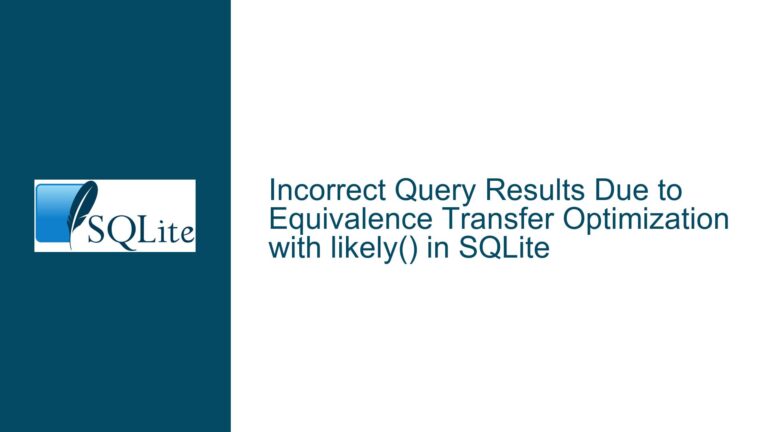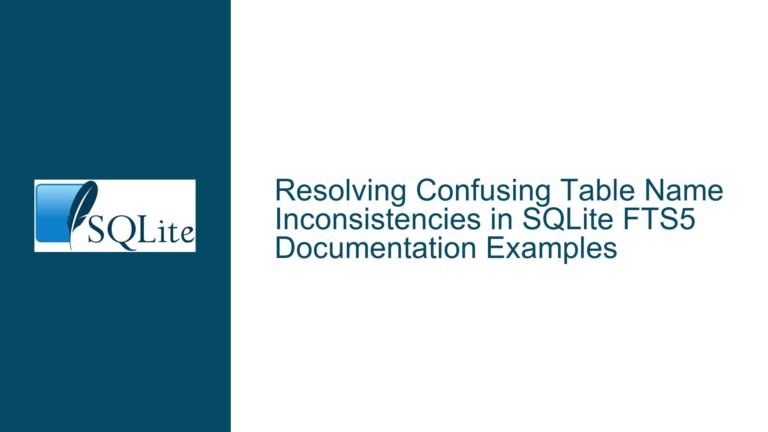Incorrect Query Results Due to Subqueries in ON Clause
Issue Overview: Subqueries in ON Clause Causing Inconsistent Results
The core issue revolves around the inconsistent results returned by two seemingly equivalent SQL queries in SQLite. The discrepancy arises when a subquery is used within the ON clause of a LEFT OUTER JOIN. The first query, which includes a CASE statement in the WHERE clause, returns zero rows, while the second query, which simplifies the WHERE clause by removing the CASE statement, returns one row. This inconsistency is unexpected because the logical conditions in both queries should yield the same result.
The database schema consists of two tables, t1 and t2, with the following structure:
CREATE TABLE t1 (vkey INTEGER, pkey INTEGER);
INSERT INTO t1 VALUES(14,24000);
CREATE TABLE t2 (vkey INTEGER, pkey INTEGER, c7 REAL, c9 REAL, c10 INTEGER);
INSERT INTO t2 VALUES(85,95000,97.87,0.0,0);
The first query (Test Case 1) is as follows:
SELECT DISTINCT
1 AS c1
FROM
((t2 AS ref_0
RIGHT OUTER JOIN t1 AS ref_1
ON (ref_0.c10 = ref_1.vkey))
LEFT OUTER JOIN (t2 AS ref_2
LEFT OUTER JOIN t1 AS ref_3
ON (ref_2.pkey = ref_3.vkey))
ON (((SELECT pkey FROM t1 ORDER BY pkey LIMIT 1) IN (
SELECT
ref_4.vkey AS c0
FROM
t2 AS ref_4
)) IS TRUE))
WHERE CASE WHEN TRUE THEN (ref_2.c9 <= ref_2.c7) ELSE TRUE END;
The second query (Test Case 2) simplifies the WHERE clause:
SELECT DISTINCT
1 AS c1
FROM
((t2 AS ref_0
RIGHT OUTER JOIN t1 AS ref_1
ON (ref_0.c10 = ref_1.vkey))
LEFT OUTER JOIN (t2 AS ref_2
LEFT OUTER JOIN t1 AS ref_3
ON (ref_2.pkey = ref_3.vkey))
ON (((SELECT pkey FROM t1 ORDER BY pkey LIMIT 1) IN (
SELECT
ref_4.vkey AS c0
FROM
t2 AS ref_4
)) IS TRUE))
WHERE (ref_2.c9 <= ref_2.c7);
The inconsistency in results between these two queries is problematic because the CASE statement in the first query should logically simplify to the condition used in the second query. This suggests that the presence of the subquery in the ON clause, combined with the CASE statement in the WHERE clause, is causing unexpected behavior in SQLite’s query execution.
Possible Causes: Subquery Evaluation and Join Condition Interaction
The inconsistency in query results can be attributed to several potential causes related to how SQLite evaluates subqueries and handles join conditions. Below are the primary factors that could be contributing to the issue:
Subquery Evaluation in the ON Clause: The subquery
(SELECT pkey FROM t1 ORDER BY pkey LIMIT 1)is evaluated within theONclause of theLEFT OUTER JOIN. This subquery is used to determine whether the join condition is satisfied. However, the interaction between this subquery and the rest of the query, particularly theWHEREclause, may not be handled correctly by SQLite’s query optimizer. The optimizer might be evaluating the subquery differently depending on the presence of theCASEstatement in theWHEREclause, leading to inconsistent results.CASE Statement in the WHERE Clause: The
CASEstatement in theWHEREclause of the first query introduces a conditional logic that should, in theory, simplify to(ref_2.c9 <= ref_2.c7)when the conditionTRUEis met. However, the presence of theCASEstatement might be causing SQLite to evaluate theWHEREclause differently, especially when combined with the subquery in theONclause. This could result in the query planner making different decisions about how to execute the query, leading to the observed inconsistency.Join Order and Optimization: SQLite’s query planner decides the order in which joins are executed and how conditions are applied. The presence of a subquery in the
ONclause can influence the join order and the way conditions are evaluated. The query planner might be choosing a different join order or optimization strategy when theCASEstatement is present, which could lead to different results. This is particularly relevant in complex queries involving multiple joins and subqueries.NULL Handling in Outer Joins: The use of
LEFT OUTER JOINandRIGHT OUTER JOINintroduces the possibility ofNULLvalues in the result set. The handling ofNULLvalues in conjunction with the subquery and theCASEstatement might be contributing to the inconsistency. SQLite’s behavior when dealing withNULLvalues in complex join conditions can sometimes lead to unexpected results, especially when subqueries are involved.Query Planner Bugs or Limitations: It is also possible that the issue is caused by a bug or limitation in SQLite’s query planner. The query planner is responsible for determining the most efficient way to execute a query, and it may not always handle complex conditions involving subqueries and
CASEstatements correctly. This could result in the planner making incorrect assumptions or optimizations that lead to inconsistent results.
Troubleshooting Steps, Solutions & Fixes: Resolving Subquery and Join Condition Issues
To address the inconsistency in query results caused by subqueries in the ON clause, the following troubleshooting steps, solutions, and fixes can be applied:
Simplify the Query: The first step in troubleshooting is to simplify the query as much as possible while still reproducing the issue. This involves removing unnecessary complexity and focusing on the core components that are causing the problem. In this case, the query can be simplified by removing the
DISTINCTkeyword and reducing the number of joins to isolate the issue. For example:SELECT 1 AS c1 FROM t2 AS ref_2 LEFT OUTER JOIN t1 AS ref_3 ON (ref_2.pkey = ref_3.vkey) WHERE (ref_2.c9 <= ref_2.c7);By simplifying the query, it becomes easier to identify whether the issue is related to the subquery in the
ONclause or theCASEstatement in theWHEREclause.Evaluate Subquery Independently: To determine whether the subquery in the
ONclause is causing the issue, evaluate the subquery independently and verify its results. For example:SELECT pkey FROM t1 ORDER BY pkey LIMIT 1;This query should return a single value, which can then be used to manually verify whether the condition in the
ONclause is being evaluated correctly. If the subquery returns an unexpected result, this could indicate an issue with the subquery itself.Check for NULL Values: Given that the query involves
LEFT OUTER JOINandRIGHT OUTER JOIN, it is important to check forNULLvalues in the result set.NULLvalues can affect the evaluation of conditions in theWHEREclause, especially when combined with subqueries. To check forNULLvalues, modify the query to include a check forNULL:SELECT 1 AS c1 FROM t2 AS ref_2 LEFT OUTER JOIN t1 AS ref_3 ON (ref_2.pkey = ref_3.vkey) WHERE (ref_2.c9 <= ref_2.c7) OR ref_2.c9 IS NULL OR ref_2.c7 IS NULL;This query will return rows where either
ref_2.c9orref_2.c7isNULL, which can help identify whetherNULLvalues are contributing to the inconsistency.Use Explicit JOIN Conditions: To avoid potential issues with subqueries in the
ONclause, consider rewriting the query to use explicit join conditions. This involves breaking down the query into smaller, more manageable parts and using temporary tables or common table expressions (CTEs) to store intermediate results. For example:WITH subquery_result AS ( SELECT pkey FROM t1 ORDER BY pkey LIMIT 1 ) SELECT 1 AS c1 FROM t2 AS ref_2 LEFT OUTER JOIN t1 AS ref_3 ON (ref_2.pkey = ref_3.vkey) LEFT OUTER JOIN subquery_result ON (subquery_result.pkey = ref_2.vkey) WHERE (ref_2.c9 <= ref_2.c7);By using a CTE to store the result of the subquery, the join condition becomes more explicit, and the query planner is less likely to make incorrect assumptions about how to evaluate the condition.
Update SQLite Version: The issue described in the discussion was fixed in a specific version of SQLite (check-in 3e9c9bbdb59b9d50). Therefore, updating to a newer version of SQLite that includes this fix should resolve the inconsistency. To update SQLite, download the latest version from the official SQLite website and follow the installation instructions for your operating system.
Review Query Execution Plan: To gain further insight into how SQLite is executing the query, review the query execution plan using the
EXPLAIN QUERY PLANstatement. This will show the order in which joins are executed and how conditions are applied. For example:EXPLAIN QUERY PLAN SELECT DISTINCT 1 AS c1 FROM ((t2 AS ref_0 RIGHT OUTER JOIN t1 AS ref_1 ON (ref_0.c10 = ref_1.vkey)) LEFT OUTER JOIN (t2 AS ref_2 LEFT OUTER JOIN t1 AS ref_3 ON (ref_2.pkey = ref_3.vkey)) ON (((SELECT pkey FROM t1 ORDER BY pkey LIMIT 1) IN ( SELECT ref_4.vkey AS c0 FROM t2 AS ref_4 )) IS TRUE)) WHERE CASE WHEN TRUE THEN (ref_2.c9 <= ref_2.c7) ELSE TRUE END;The output of
EXPLAIN QUERY PLANwill provide detailed information about the query execution plan, which can help identify any inefficiencies or incorrect assumptions made by the query planner.Consider Alternative Database Engines: If the issue persists and cannot be resolved within SQLite, consider using an alternative database engine that may handle complex queries more effectively. Lightweight databases such as MySQL, PostgreSQL, or MariaDB may offer better support for complex join conditions and subqueries. However, this should be considered a last resort, as migrating to a different database engine can be a significant undertaking.
By following these troubleshooting steps and applying the appropriate solutions, the inconsistency in query results caused by subqueries in the ON clause can be resolved. It is important to carefully analyze the query structure, evaluate subqueries independently, and consider the impact of NULL values and join conditions on the query results. Additionally, updating to the latest version of SQLite and reviewing the query execution plan can provide further insights into the issue and help ensure that the query returns the expected results.






